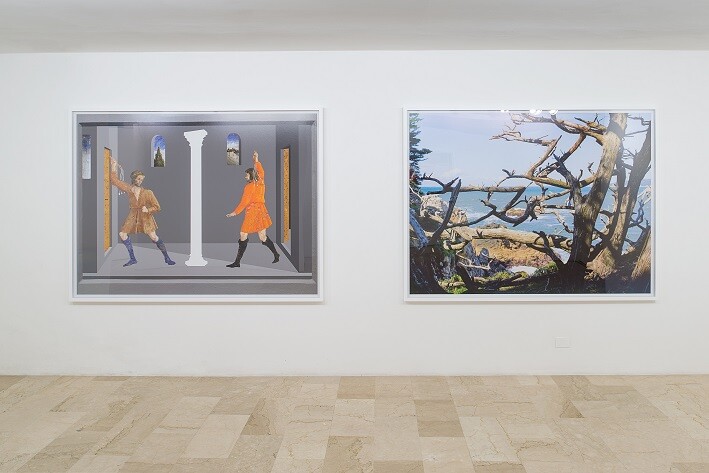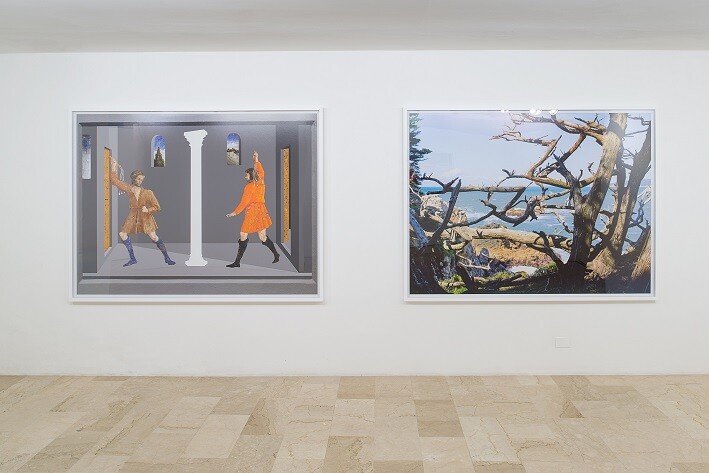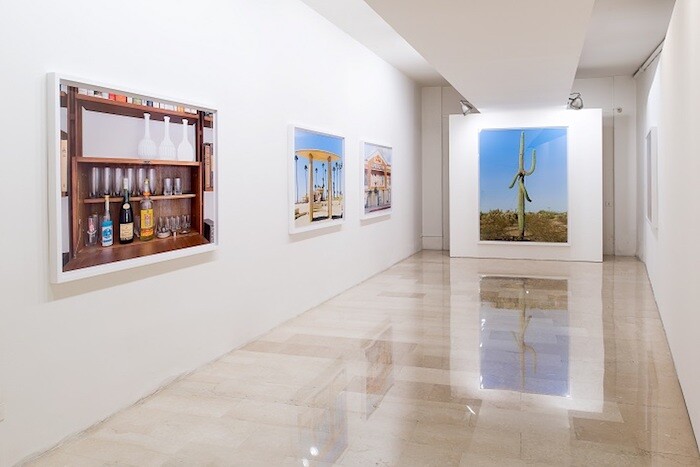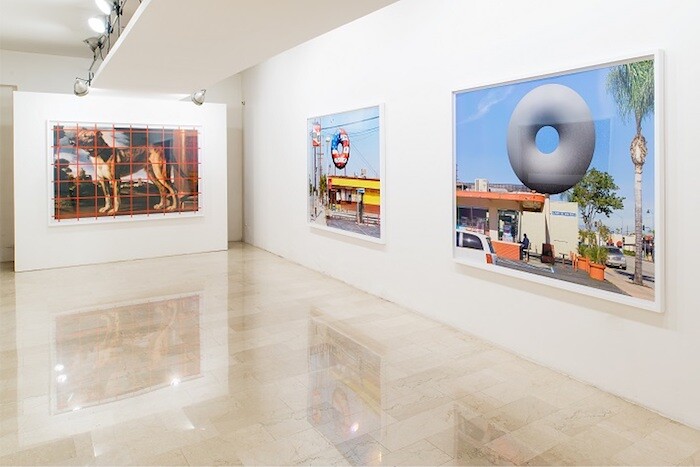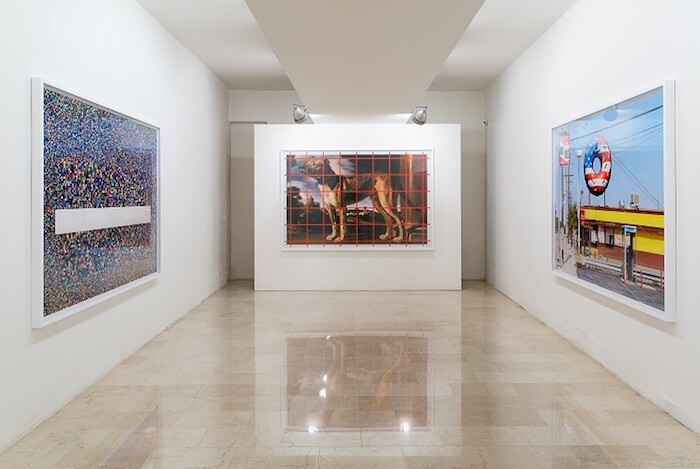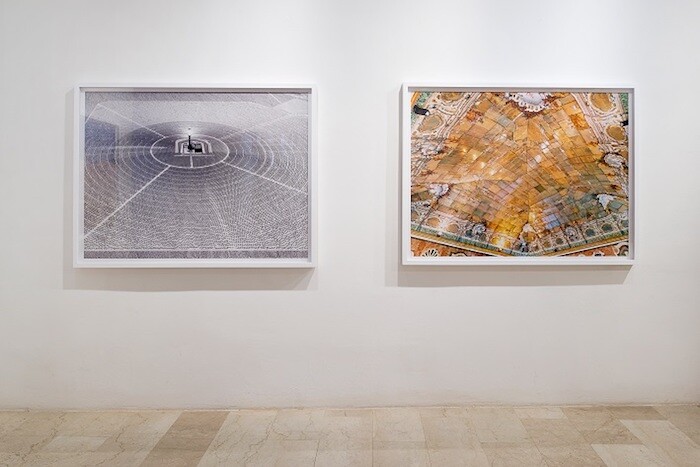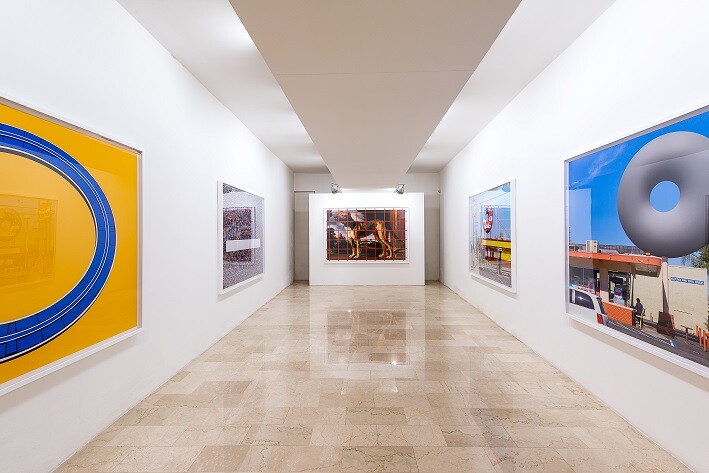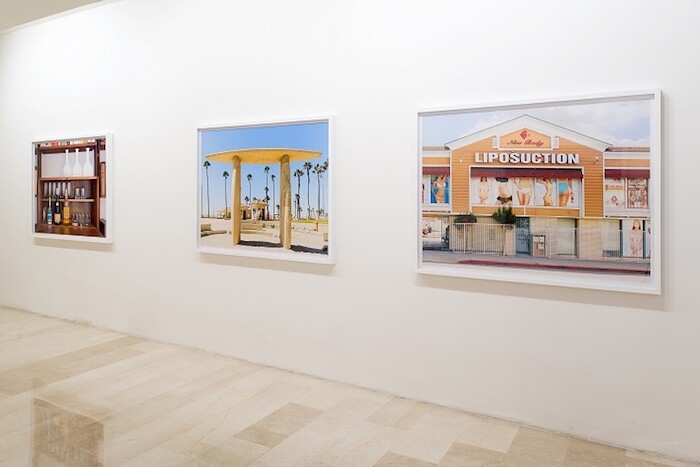Olivo Barbieri’s new solo show—the title of which winks at The American Monument (1976), the acclaimed, anti-spectacular photography book by Lee Friedlander, in which he photographed grand civic monuments against the quotidian surroundings of billboards, streets, and parks—comprises a group of 20 large-format photographs, almost all taken in 2017 in California, alongside a few that relate to Italian art, such as photographs of paintings by Piero della Francesca and Guercino. At first, the show appears to present a stereotypical America: the America of Silicon Valley (Apple Park Cupertino CA), guns (South Boulder City NV), fertility clinics (Redwood City CA), heroic artists (Hamburger Monument #2 after Mark Rothko White Center 1957 LACMA Los Angeles), liposuction centers (Los Angeles CA), or donut-shaped signs (Long Beach CA).
But for Barbieri, this America—which stands, for him, for the West more broadly and, as Oswald Spengler saw it, its imminent decline—is also a personal fund of memories. “I happened to be passing through Florence, in Arizona,” he says, pointing Tom Mix Monument Florence AZ, a photograph of a battered metal cut-out of a horse riddled with bullets, “when I recognized this monument to [American movie star] Tom Mix that I had seen in one of Friedlander’s photographs [In Memory of Tom Mix, 1975]. When I was a child, my father used to say he was Tom Mix when we played cowboys and Indians, but I never understood who he was until I saw this photo.” Similarly, the picture of an inlet of the sea in California (Point Lobos CA) is “a homage to the shrine of American photography, where the myths of Edward Weston and Ansel Adams were born.”
That said, Barbieri’s “monuments” cannot simply be seen as a study of vernacular architecture in the manner of Robert Venturi, Denise Scott Brown, and Steven Izenour’s book on postmodern architecture Learning from Las Vegas (1972), in which the dignity of donut signs on drive-in roofs was considered for the first time. In Barbieri’s work, representation is stripped of any pretense of reality, pushed to the point of abstraction. Depth of field is extended for miles. (Barbieri takes the same shot again and again, gradually shifting the focus and then blending all the images into a single picture.) The motif of the generic donut sign turns into a geometric solid, while Mark Rothko’s White Center (1957) becomes a minimalist hamburger. Barbieri starts out from reality and goes back to the plan—and vice versa. He has no problems with the idea of the “almost fake.”
This is evident from his uninhibited juxtaposition of three- and two-dimensional images, digital models, and old canvases. “The exhibition opens with a painting by Piero della Francesca, who died the year of America’s discovery,” says Barbieri, spreading his hands before the photograph of a famous predella depicting a flagellation, from which he has eliminated the figure of Christ (After Piero della Francesca Polittico della Madonna della Misericordia 1445-1462 Museo Civico Sansepolcro Arezzo). “The two floggers are left whipping a column. It is the West scourging itself.” He indicates the painting of a mastiff in the Portrait of the Aldrovandi Dog, which he has first photographed and then confined behind a red grating (Archetypal Pet after Giovanni Francesco Barbieri Called Guercino Aldrovandi Dog c. 1625 Pasadena CA). “This picture of Guercino’s,” Barbieri says, as if to stress a common frame of reference, “was in Bologna before ending up in the collection of the Norton Simon Museum of Art in Pasadena.”
I ask him why the dog is caged. He answers that “that photograph of Kubrick where you see a monkey and, behind the monkey, a crowd of people looking at it through the bars” (How People Look to Monkeys, 1946). All the meaning lies in the focus (on the cage) as well as in the captive exchange of gazes (the monkey is looking at the photographer, who is looking at the people, who are looking at the monkey). In Barbieri’s exhibition, elementary forms refer to one another: the Apple Park in Cupertino, California, and the donut at the drive-in share a similar circular shape to the parabolic concentrators of a solar energy plant (Ivanpah Solar Electric Generating System CA), or the arrangement of mirrors on the ceiling of an eighteenth-century Italian villa (Hall of Mirrors Villa dei Mostri 1715-1737 Bagheria Palermo). And the white column in Piero della Francesca’s Flagellation is echoed in the white pillars on the empty plinths of an Italian Catholic church (Incompiuto Siciliano Prototype Chiesa di San Nicolò l’Arena 1687 Catania), or in the white bottles he has lined up on the bar of Giorgio Morandi’s vacation home (Giorgio Morandi’s Home Bar 1964 Grizzana Morandi Bologna). Diminished in their symbolic charge, these monuments are precarious. Or perhaps they are no longer monuments, in which case Barbieri’s operation would reflect more anxiety than apology: the looking would become a looking at himself. Alternatively, as the curator Tobia Bezzola puts it in an essay accompanying the show, they are indeed monuments, but only in their etymological sense of monere—“to remind.”
In Kubrick’s photograph Observing People Observing Monkeys (1946), the people behind the bars are looking at the monkey—but this time, it’s out of the frame. Could the American flag be a shroud? “No,” replies Barbieri, “in these photographs there is no passing away of the subject, but the subject is not what everyone is expecting, the obvious thing that everyone is waiting for: the monkey behind the bars, that is.”
